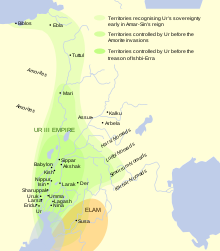CITIES IN MESOPOTAMIA IN THE 3RD CENTURY
Cities were built as early as
10-12,000 years ago. People stopped hunting/gathering and settled more in one
place. To begin with there were small farms and villages but they were not cities.
The world first great civilization
arose in the Middle East, in Mesopotamia and Indus Valley.
Cities started to be built when
craftsmen, traders, priests, soldiers and officials came together and were
building houses. For cities to survive and prosper farmers had to produce more
food and sell them on the market places.
Early large settlements appeared like
the town of Jericho was inhabited before 8000 BC. A recently archaeological
find in Turkey, a town called Catal Huyuk (pronounced Chatal Hoo-yook)
apparently, it flourished from about 6500 to 5500 BC. Unfortunately, the
knowledge is limited because there are no written records. A kind of writing
started in southern Iraq about 3000 BC at a place called Sumer.
EMPIRE OF THE THIRD DYNASTY OF UR
The good farmland was in the northern
territory of Iraq. Sumer did have rich soil but had to be drained because it
was marshland. A highly organized effort must have been made to carefully
irrigate the land. It is assumed that the whole population took part and
afterwards to maintain it. When it started to be productive and prosperous
Sumer was divided into independent-city-states. Walled cities like Ur, Uruk,
Kish, Lagash and Nippur had its capital with villages and countryside.
Although rich on food Sumer was had
no timber or stones. This meant that large amount of stone were not possible to
transport. They used mud bricks which were either baked in the sun or in
oven. They managed to build all these big cities with it. However, being a perishable
material it did not survive of thousands of years. Surprisingly, some survived
at all to give us an idea of the magnificent cities.
There were tall pyramids call
ziggurats with steps leading up to the shrine of a god. Each city had its own
god. It was built around the temple.
Priests had a good deal of power.
Furthermore, the earliest monarchies were established in Sumer and the first
known code of law was made in Ur. King Ur-Nammu reign c.2100BC.
RECONSTRUCTED
FACADE OF THE NEO-SUMARIAN GREAT ZIGGURAT
OF UR -- NEAR NASIRIYAH, IRAQ
In Sumer there was also the first
wheeled wagon, the potter's wheel and most importantly writing was developed
there. At first it was only simple lists and picture writing. Later on they
developed a wedge-shaped writing on a wet clay tablet which when dried out was
a perfect record. It kept a perfect literature about myth and legends of the
Sumarians.
Civilization appeared a few hundred
years in Sumer before ancient Egypt.
Another but mysterious civilization was
in the Indus Valley (today's Pakistan) around 2500BC. There is only the
city-sites of Mhoenjo-Daro and Harappa known of that great civilization. So far
there was no possibility of decipher the picture writing of a few examples. It
is not know who these people were. Their remarkable cities had straight
criss-cross roads at a right-angle. Therefore, it is assumed that these cities
must have been built before they were inhabited. Their civilization collapsed
about 1700 BC but to these days the reason is no known.
Eventually, Sumer also vanished
because they were warring amongst each other which enabled outsiders to
conquer. They fought off many a time the invaders. Their golden days were under
the third dynasty of Ur. It was established under the Ur-Nammu.
After the defeat by the Amorites
about 1900 BC the Sumarians merged with the history of the Babylonia.
+BESTOWS+GOVERNORSHIP+ON+HASHAMER,+PATES+(HIGH+PRIEST)+OF+ISKUN-SIN+ABOUT+2100+BC.jpg) |
PRIESTES UR-NAMMY - SEATED |



I am sorry I did not see your wonderful compliment before. Please do not hold it against me. I am so pleased to receive such praise. Thank you ever so much.
ReplyDelete